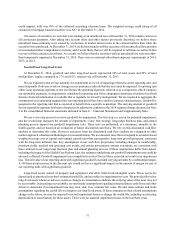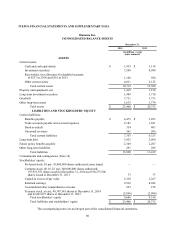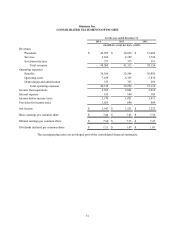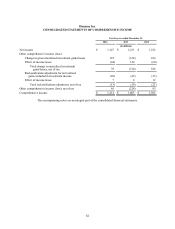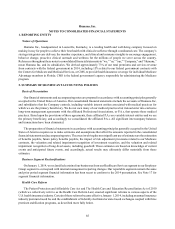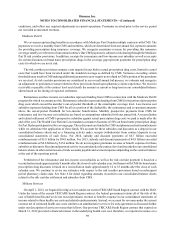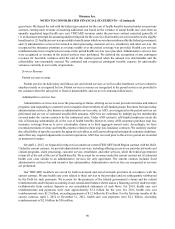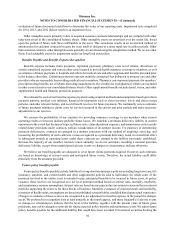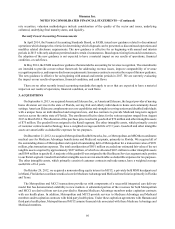Humana 2014 Annual Report Download - page 95
Download and view the complete annual report
Please find page 95 of the 2014 Humana annual report below. You can navigate through the pages in the report by either clicking on the pages listed below, or by using the keyword search tool below to find specific information within the annual report.Humana Inc.
NOTES TO CONSOLIDATED FINANCIAL STATEMENTS—(Continued)
87
making additional payments to us or require us to refund HHS a portion of the premiums we received. HHS guidance
provides that risk corridor collections over the life of the three year program will first be applied to any shortfalls from
previous benefit years before application to current year obligations.
We estimate and recognize adjustments to premiums revenue for the risk adjustment and risk corridor provisions
by projecting our ultimate premium for the calendar year separately for individual and group plans by state and legal
entity. Estimated calendar year settlement amounts are recognized ratably during the year and are revised each period
to reflect current experience, including changes in risk scores derived from medical diagnoses submitted by providers.
We record receivables or payables at the individual or group level within each state and legal entity and classify the
amounts as current or long-term in our consolidated balance sheets based on the timing of expected settlement.
The transitional reinsurance program requires us to make reinsurance contributions for calendar years 2014 through
2016 to a state or HHS established reinsurance entity based on a national contribution rate per covered member as
determined by HHS. While all commercial medical plans, including self-funded plans, are required to fund the
reinsurance entity, only fully-insured non-grandfathered plans compliant with the Health Care Reform Law in the
individual commercial market will be eligible for recoveries if individual claims exceed a specified threshold.
Accordingly, we account for transitional reinsurance contributions associated with all commercial medical health plans
other than these non-grandfathered individual plans as an assessment in operating costs in our consolidated statements
of income. We account for contributions made by individual commercial plans compliant with the Health Care Reform
Law, which are subject to recoveries, as ceded premiums (a reduction of premiums) and similarly we account for any
recoveries as ceded benefits (a reduction of benefits expense) in our consolidated statements of income.
We are required to remit payment for our per member reinsurance contribution, exclusive of the portion payable
to the U.S. Treasury, by January 15 of the year following the benefit year, or January 15, 2015 for the 2014 benefit
year. The portion of the reinsurance contribution due to the U.S. Treasury must be paid by November 15 of the year
following the benefit year, or November 15, 2015 for the 2014 benefit year. Risk adjustment calculations will be
completed and HHS will notify us of recoveries due or payments owed to/from us under the risk adjustment and
reinsurance programs by June 30 of the year following the benefit year. Following this notification, risk corridor
calculations are then due by July 31 of the year following the benefit year. Payments due to HHS under the risk adjustment
and risk corridor programs must be remitted within 30 days of notification for each program and will be collected prior
to the distribution of recoveries by HHS under each program. Payment and recovery amounts will be settled with HHS
annually in the second half of the year following the benefit year. Accordingly, for the 2014 benefit year, we expect to
receive recoveries and/or pay amounts due under these programs in the second half of 2015.
In addition to the provisions discussed above, beginning in 2014, HHS pays us a portion of the health care costs
for low-income individual members for which we assume no risk in accordance with the Health Care Reform Law. We
account for these subsidies as a deposit in our consolidated balance sheets and as a financing activity in our consolidated
statements of cash flows. We do not recognize premiums revenue or benefits expense for these subsidies. Receipt and
payment activity is accumulated at the state and legal entity level and recorded in our consolidated balance sheets in
other current assets or trade accounts payable and accrued expenses depending on the state and legal entity balance at
the end of the reporting period. We will be notified of final settlement amounts by June 30 of the year following the
benefit year. Receipts from HHS associated with cost sharing subsidies for which we do not assume risk were
approximately $281 million, exceeding payments of $255 million by $26 million for the year ended December 31,
2014. See Note 7 for detail regarding amounts recorded to the consolidated balance sheets related to the 3Rs.
Cash and Cash Equivalents
Cash and cash equivalents include cash, time deposits, money market funds, commercial paper, other money market
instruments, and certain U.S. Government securities with an original maturity of three months or less. Carrying value
approximates fair value due to the short-term maturity of the investments.
Investment Securities
Investment securities, which consist entirely of debt securities, have been categorized as available for sale and, as
a result, are stated at fair value. Investment securities available for current operations are classified as current assets.


